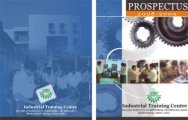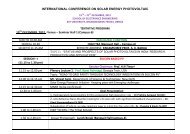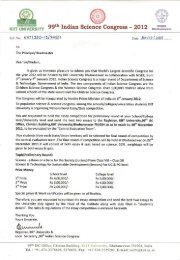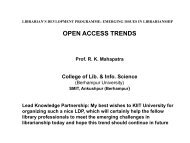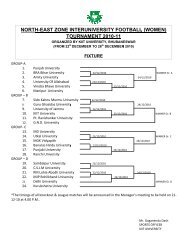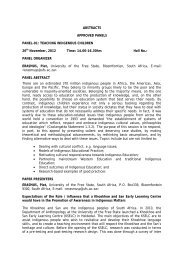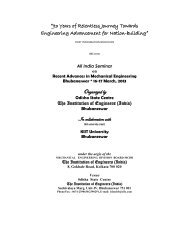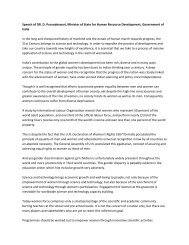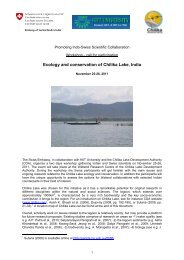download - KIIT University
download - KIIT University
download - KIIT University
You also want an ePaper? Increase the reach of your titles
YUMPU automatically turns print PDFs into web optimized ePapers that Google loves.
Dr.K.C.DAS<br />
HEAD<br />
PG Dept. of Library & Inf. Science<br />
Utkal <strong>University</strong>, Vani Vihar,Bhubaneswar
There is potential for a lot of confusion<br />
surrounding the definition of cloud<br />
computing. In its basic conceptual<br />
form, cloud computing involves five<br />
primary fundamentals:<br />
shared resources,<br />
on-demand,<br />
elasticity,<br />
networked access, and<br />
usage-based<br />
metering.<br />
Dr. K. C. Das HOD, PG Dept. of Lib<br />
& Inf.Sc., Utkal<br />
<strong>University</strong>,Bhubaneswar 17 April 2013<br />
2
Shared resources are the shared pool of IT resources,<br />
such as applications, processors, storage and<br />
databases.<br />
On-Demand allows users to call up resource from the<br />
cloud and use them as needed. When the user is<br />
finished with the resources they release them in a<br />
self-service fashion.<br />
Elasticity, or flexibility that includes scalability,<br />
allows the cloud to be dynamic to the users demands<br />
allowing the cloud to satisfy peak demands and then<br />
release resources when demand subsides.<br />
Networked access allows the cloud to be accessible<br />
widely, primarily though the internet.<br />
Lastly, the usage-based metering allows users of the<br />
cloud to pay for the services when needed and used<br />
and to release them when they are no longer need,<br />
resulting in many benefits including cost and storage<br />
efficiency.<br />
Dr. K. C. Das HOD, PG Dept. of Lib<br />
& Inf.Sc., Utkal<br />
<strong>University</strong>,Bhubaneswar 17 April 2013<br />
3
The foundation of cloud computing is<br />
virtualization .Virtualization is the consolidation<br />
of servers and environment management.<br />
Cloud Computing can be defined as “A model for<br />
enabling ubiquitous, convenient, on-demand<br />
network access to a shared pool of configurable<br />
computing resources (e.g., networks, servers,<br />
storage, applications, and services) that can be<br />
rapidly provisioned and released with minimal<br />
management effort or service provider<br />
interaction.”<br />
Dr. K. C. Das HOD, PG Dept. of Lib<br />
& Inf.Sc., Utkal<br />
<strong>University</strong>,Bhubaneswar<br />
17 April 2013 4
- the Fifth Generation of Computing<br />
(after Mainframe, Personal Computer,<br />
Client-Server Computing, and the web)<br />
- the biggest thing since the web<br />
Dr. K. C. Das HOD, PG Dept. of Lib<br />
& Inf.Sc., Utkal<br />
<strong>University</strong>,Bhubaneswar<br />
17 April 2013 5
Dr. K. C. Das HOD, PG Dept. of Lib<br />
& Inf.Sc., Utkal<br />
<strong>University</strong>,Bhubaneswar 17 April 2013<br />
6
DACUN<br />
Library<br />
Committee<br />
"Cloud Computing," to put it simply, means<br />
"Internet Computing." The Internet is<br />
commonly visualized as clouds; hence the<br />
term “cloud computing” for computation<br />
done through the Internet. With Cloud<br />
Computing users can access database<br />
resources via the Internet from anywhere, for<br />
as long as they need, without worrying about<br />
any maintenance or management of actual<br />
resources.<br />
http://dotnetslackers.com/articles/sql/Introduction-to-Cloud-<br />
Computing.aspx<br />
Dr. K. C. Das HOD, PG Dept. of Lib<br />
& Inf.Sc., Utkal<br />
<strong>University</strong>,Bhubaneswar<br />
17 April 2013 7
DACUN<br />
Library<br />
Committee<br />
“Cloud computing is<br />
Internet-based<br />
computing, whereby<br />
shared resources,<br />
software, and<br />
information are<br />
provided to<br />
computers and other<br />
devices on demand<br />
through the Internet”<br />
Dr. K. C. Das HOD, PG Dept. of Lib<br />
& Inf.Sc., Utkal<br />
<strong>University</strong>,Bhubaneswar<br />
17 April 2013 8
Ellyssa Kroski<br />
Library Journal,<br />
09/10/2009<br />
Ellyssa Kroski --<br />
Library Journal,<br />
09/10/2009<br />
“… means using Web<br />
services for our<br />
computing needs<br />
which could include<br />
using software<br />
applications, storing<br />
data, accessing<br />
computing power, or<br />
using a platform to<br />
build applications. “<br />
Dr. K. C. Das HOD, PG Dept. of Lib<br />
& Inf.Sc., Utkal<br />
<strong>University</strong>,Bhubaneswar<br />
17 April 2013 9
Cloud computing is a<br />
general term for anything<br />
that involves delivering<br />
hosted services over the<br />
Internet.<br />
These services are broadly<br />
divided into three categories:<br />
Infrastructure-as-a-Service<br />
(IaaS), Platform-as-a-Service<br />
(PaaS) and<br />
Software-as-a-Service (SaaS).<br />
Dr. K. C. Das HOD, PG Dept. of Lib<br />
& Inf.Sc., Utkal<br />
<strong>University</strong>,Bhubaneswar<br />
17 April 2013 10
McKinsey:<br />
“Clouds are hardwarebased<br />
services offering<br />
compute, network and<br />
storage capacity where:<br />
Hardware management is<br />
highly abstracted from<br />
the buyer, Buyers incur<br />
infrastructure costs as<br />
variable OPEX<br />
(operational expenditure),<br />
and<br />
Infrastructure capacity is<br />
highly elastic”<br />
Dr. K. C. Das HOD, PG Dept. of Lib<br />
& Inf.Sc., Utkal<br />
<strong>University</strong>,Bhubaneswar<br />
17 April 2013 11
“…is a model for enabling<br />
convenient, on-demand<br />
network access to a<br />
shared pool of<br />
configurable computing<br />
resources (for ex.,<br />
networks, servers, storage,<br />
applications, and services)<br />
that can be rapidly<br />
provisioned and released with<br />
minimal management effort<br />
or service provider<br />
interaction.“<br />
Source: National Institute of Standards and<br />
Technology<br />
(NIST)<br />
Dr. K. C. Das HOD, PG Dept. of Lib & Inf.Sc.,<br />
17 April 2013 Utkal <strong>University</strong>,Bhubaneswar<br />
12
FZI (Jens Nimis):<br />
”Building on compute and<br />
storage virtualization,<br />
cloud computing provides<br />
scalable, network-centric,<br />
abstracted IT<br />
infrastructure, platforms,<br />
and applications as ondemand<br />
services that are<br />
billed by consumption.”<br />
Dr. K. C. Das HOD, PG Dept. of Lib<br />
& Inf.Sc., Utkal<br />
<strong>University</strong>,Bhubaneswar<br />
17 April 2013 13
Source: IDC October 2008<br />
Dr. K. C. Das HOD, PG Dept. of Lib<br />
& Inf.Sc., Utkal<br />
<strong>University</strong>,Bhubaneswar<br />
17 April 2013 14
Dr. K. C. Das HOD, PG Dept. of Lib<br />
& Inf.Sc., Utkal<br />
<strong>University</strong>,Bhubaneswar<br />
17 April 2013 15
‣ it is delivered over a telecommunications network<br />
‣ users place reliance on the service for data<br />
access and/or data processing<br />
‣ the data is under the legal control of the user<br />
‣ some of the resources on which the service<br />
depends are virtualised, i.e. the user doesn’t<br />
need any technical awareness about which server<br />
is running or which host is delivering the service,<br />
nor where the hosting device is located the<br />
service is acquired under a relatively flexible<br />
contractual arrangement<br />
Dr. K. C. Das HOD, PG Dept. of Lib<br />
& Inf.Sc., Utkal<br />
<strong>University</strong>,Bhubaneswar<br />
17 April 2013 16
On-demand self-service (i.e. automated<br />
response by servers to direct requests by clients)<br />
Broad network access (i.e. from anywhere, using<br />
any device)<br />
Resource pooling (i.e. the provider allocates<br />
resources according to demand, rather than<br />
assigning resources to particular clients)<br />
Rapid elasticity (i.e. resources are scalable<br />
according to demand)<br />
Measured service (i.e. resource usage is<br />
metered)<br />
Dr. K. C. Das HOD, PG Dept. of Lib<br />
& Inf.Sc., Utkal<br />
<strong>University</strong>,Bhubaneswar<br />
17 April 2013 17
Software as a Service (SaaS)<br />
Platform as a Service (PaaS)<br />
Infrastructure as a Service (IaaS)<br />
Dr. K. C. Das HOD, PG Dept. of Lib<br />
& Inf.Sc., Utkal<br />
<strong>University</strong>,Bhubaneswar<br />
17 April 2013 18
Dr. K. C. Das HOD, PG Dept. of Lib<br />
& Inf.Sc., Utkal<br />
<strong>University</strong>,Bhubaneswar 17 April 2013<br />
19
The applications are accessible from various<br />
client devices through a thin client interface<br />
such as a web browser (e.g., web-based<br />
email).<br />
The user does not manage or control the<br />
underlying cloud infrastructure including<br />
network, servers, operating systems, storage,<br />
or even individual application capabilities,<br />
with the possible exception of limited userspecific<br />
application configuration settings.<br />
Dr. K. C. Das HOD, PG Dept. of Lib<br />
& Inf.Sc., Utkal<br />
<strong>University</strong>,Bhubaneswar<br />
17 April 2013 20
PaaS provides an application platform, or<br />
middleware, as a service on which developers<br />
can build and deploy custom applications.<br />
Common solutions provided in this tier range<br />
from APIs and tools to database and business<br />
process management systems to security<br />
integration, allowing developers to build<br />
applications and run them on the<br />
infrastructure that the cloud vendor owns and<br />
maintains.<br />
Dr. K. C. Das HOD, PG Dept. of Lib<br />
& Inf.Sc., Utkal<br />
<strong>University</strong>,Bhubaneswar<br />
17 April 2013 21
It is the capability provided to the user to<br />
enable processing, storage, networks, and<br />
other fundamental computing resources<br />
where the user is able to deploy and run<br />
arbitrary software, which can include<br />
operating systems and applications. The user<br />
does not manage or control the underlying<br />
cloud infrastructure but has control over<br />
operating systems, storage, deployed<br />
applications, and possibly limited control of<br />
select networking components.<br />
Dr. K. C. Das HOD, PG Dept. of Lib<br />
& Inf.Sc., Utkal<br />
<strong>University</strong>,Bhubaneswar<br />
17 April 2013 22
Public clouds computing environment are<br />
open for use to anyone who wants to sign<br />
up and use them. These are run by vendors<br />
and applications from different customers<br />
are likely to be mixed together on the<br />
cloud’s servers, storage systems, and<br />
networks.<br />
Examples of a public cloud: Amazon Web<br />
Services and Google's AppEngine<br />
Source: Wikipedia<br />
Dr. K. C. Das HOD, PG Dept. of Lib & Inf.Sc.,<br />
17 April 2013 Utkal <strong>University</strong>,Bhubaneswar<br />
23
A private cloud is<br />
basically an organization<br />
that needs more control<br />
over their data than they<br />
can get by using a<br />
vendor hosted service.<br />
A hybrid cloud combine<br />
both public and private<br />
cloud models.<br />
Dr. K. C. Das HOD, PG Dept. of Lib<br />
& Inf.Sc., Utkal<br />
<strong>University</strong>,Bhubaneswar<br />
17 April 2013 24
Google<br />
Cordys<br />
Microsoft<br />
Amazon<br />
Force.com<br />
MOSSO<br />
IBM<br />
Dr. K. C. Das HOD, PG Dept. of Lib<br />
& Inf.Sc., Utkal<br />
<strong>University</strong>,Bhubaneswar<br />
17 April 2013 25
Dr. K. C. Das HOD, PG Dept. of Lib<br />
& Inf.Sc., Utkal<br />
<strong>University</strong>,Bhubaneswar<br />
17 April 2013 26
1. Assured maximum availability of your data, application<br />
and infrastructure<br />
2. Need to pay only for what has been used (i.e. Bandwidth,<br />
Resources)<br />
3. Relieves burden of IT staff within organization, as routine<br />
jobs are being handled by service providers<br />
4. Easily scalable as per requirement of organization<br />
Another benefit of cloud computing is that it addresses<br />
resource management in profoundly better ways. Through<br />
a cloud computing environment users can save and<br />
eliminate cost in services, personnel, and IT infrastructure.<br />
<br />
Reducing cost is one of the major attractions to cloud<br />
computing. Lastly, the new resources requested by a user<br />
can be delivered much faster.<br />
General disadvantages of cloud are dependency upon<br />
network connectivity, security, legal issues(ownership of<br />
data), latency etc. which needs to be carefully reviewed.<br />
Dr. K. C. Das HOD, PG Dept. of Lib<br />
& Inf.Sc., Utkal<br />
<strong>University</strong>,Bhubaneswar<br />
17 April 2013 27
Most common library services can be scoped in<br />
to following three categories.<br />
Data: Bibliographic, Technical, Access,<br />
Licence<br />
Content: Collection, Subscription, Digital,<br />
Print, Publishing.<br />
Services: Library as a place, content-access,<br />
content-creation, research, preservation<br />
Dr. K. C. Das HOD, PG Dept. of Lib<br />
& Inf.Sc., Utkal<br />
<strong>University</strong>,Bhubaneswar<br />
17 April 2013 28
There are very few libraries which are having<br />
IT support staff with expertise on advance IT<br />
management. This situation makes SaaS, PaaS<br />
or IaaS approach tempting to move towards<br />
cloud computing for providing better library<br />
services.<br />
Dr. K. C. Das HOD, PG Dept. of Lib<br />
& Inf.Sc., Utkal<br />
<strong>University</strong>,Bhubaneswar<br />
17 April 2013 29
Libraries have been adopting cloud-based<br />
solutions services like electronic journal<br />
access management, statistics tracking,<br />
digital library hosting and now trend is<br />
coming up for hosted library management<br />
systems.<br />
Dr. K. C. Das HOD, PG Dept. of Lib<br />
& Inf.Sc., Utkal<br />
<strong>University</strong>,Bhubaneswar<br />
17 April 2013 30
The use of SaaS in libraries dates back to early<br />
2000 with the establishment of companies like<br />
Serials Solutions (http://serialssolutions.com).<br />
There are also examples of availability of hosting<br />
platforms like INFLIBNET’s OJAS (Open Journal<br />
Academic System) available at<br />
http:/www.inflibnet.ac.in/ojs/, For Institutional<br />
repositories there is http://duracloud.org/, for<br />
open publishing http://www.biomedcentral.com/<br />
is a well-known platform.<br />
Dr. K. C. Das HOD, PG Dept. of Lib<br />
& Inf.Sc., Utkal<br />
<strong>University</strong>,Bhubaneswar<br />
17 April 2013 31
In the IaaS, one of the pioneer i.e Amazon Elastic<br />
Computing Cloud (EC2) offers IT infrastructure<br />
with differently sized servers using a choice of<br />
operating systems, including several flavours of<br />
Linux and Windows.<br />
EC2 provides organizations with unlimited<br />
storage using Simple Storage Service(S3), the<br />
ability to take snapshots of both data and<br />
servers, and the ability to include EC2 servers in<br />
an organization’s private network. A full<br />
catalogue of EC2 features is available on the EC2<br />
website (http://aws.amazon.com/ec2/).<br />
Dr. K. C. Das HOD, PG Dept. of Lib<br />
& Inf.Sc., Utkal<br />
<strong>University</strong>,Bhubaneswar<br />
17 April 2013 32
By using cloud technologies, library services<br />
can be made online without worrying about<br />
correct versions of platforms or the<br />
underlying technology.<br />
It also gives facility to induce new<br />
applications quickly without having to focus<br />
on identifying available server space or<br />
configuration and IT-based library services<br />
can be delivered much more quickly than<br />
when using locally-based hardware or<br />
software.<br />
Dr. K. C. Das HOD, PG Dept. of Lib<br />
& Inf.Sc., Utkal<br />
<strong>University</strong>,Bhubaneswar<br />
17 April 2013 33
Dr. K. C. Das HOD, PG Dept. of Lib<br />
& Inf.Sc., Utkal<br />
<strong>University</strong>,Bhubaneswar<br />
17 April 2013 34
Cloud computing reduce energy<br />
consumption significantly. The 1000 plus US<br />
government data centers, for example, were consuming 6<br />
billion kWh of energy in 2006, and if left unchecked, the<br />
consumption can be more than double by 2013.<br />
Cloud computing involves centralizing the<br />
computing resources on the Internet (the<br />
cloud) and making these available to those<br />
who need it, when needed. Because the<br />
resources are shared by many, capacity utilization<br />
goes up. And modern developments like<br />
virtualization can make the same resources<br />
available to multiple users "simultaneously," thus<br />
reducing the need for physical resources even<br />
further.<br />
Dr. K. C. Das HOD, PG Dept. of Lib<br />
& Inf.Sc., Utkal<br />
<strong>University</strong>,Bhubaneswar<br />
17 April 2013 35
At the micro level, enterprises that used<br />
cloud computing services are freed of<br />
worrying about the technological issues<br />
related to IT installations. They can replace their<br />
complex installations of servers, workstations, networking<br />
and numerous applications with simple workstation<br />
computers and fast Internet connectivity. The cloud service<br />
providers will attend to the infrastructure, platforms and even<br />
applications needed by the enterprises.<br />
Cloud computing resources are available<br />
immediately as soon as the agreement with<br />
the service provider is executed. Under the<br />
utility model of service provision, users are charged only for<br />
what they use, for the memory, CPU, data transfer, I/O<br />
requests, storage space and so on. As the business expands,<br />
the enterprises can seamlessly expand their computing<br />
capacities.<br />
Dr. K. C. Das HOD, PG Dept. of Lib<br />
& Inf.Sc., Utkal<br />
<strong>University</strong>,Bhubaneswar<br />
17 April 2013 36
Universities can open their technology<br />
infrastructures to businesses and industries for<br />
research advancements;<br />
The efficiencies of cloud computing can help<br />
universities keep pace with ever-growing<br />
resource requirements and energy cost;<br />
The extended reach of cloud computing<br />
enables institutions to teach students in new,<br />
different ways and help them manage projects<br />
and massive workloads; and<br />
When students enter the global workforce they<br />
will better understand the value of new<br />
technologies.<br />
Dr. K. C. Das HOD, PG Dept. of Lib<br />
& Inf.Sc., Utkal<br />
<strong>University</strong>,Bhubaneswar<br />
17 April 2013 37
Cloud computing has brought us a new<br />
perspective to look at the current resourcesharing<br />
problem, cloud computing can be<br />
applied to digital library resources to improve<br />
information sharing capabilities, improve<br />
resource utilization.<br />
Dr. K. C. Das HOD, PG Dept. of Lib<br />
& Inf.Sc., Utkal<br />
<strong>University</strong>,Bhubaneswar<br />
17 April 2013 38
“Cloud computing” is<br />
emerging as a<br />
relevant computing<br />
paradigm aiming to<br />
be the technology<br />
that will mark the<br />
difference between<br />
Web2.0<br />
and<br />
Web3.0.<br />
Dr. K. C. Das HOD, PG Dept. of Lib<br />
& Inf.Sc., Utkal<br />
<strong>University</strong>,Bhubaneswar<br />
17 April 2013 39
Software as a<br />
Subscription<br />
Reduced Software<br />
Maintenance<br />
Increased<br />
Reliability<br />
Increased<br />
Scalability<br />
Dr. K. C. Das HOD, PG Dept. of Lib<br />
& Inf.Sc., Utkal<br />
<strong>University</strong>,Bhubaneswar<br />
17 April 2013 40
Cost Reduction<br />
Environmentally Friendly<br />
Matches Current<br />
Computing Trends<br />
Portability/Accessibility<br />
Efficient Use of Computer<br />
Resources<br />
Versionless Software<br />
Dr. K. C. Das HOD, PG Dept. of Lib<br />
& Inf.Sc., Utkal<br />
<strong>University</strong>,Bhubaneswar<br />
17 April 2013 41
Cost savings<br />
Flexibility and innovation<br />
Broad, general IT skills vs. deep,<br />
specialized skills<br />
Cloud OPAC and Cloud ILS<br />
Private clouds, hybrid clouds and<br />
community clouds<br />
Dr. K. C. Das HOD, PG Dept. of Lib<br />
& Inf.Sc., Utkal<br />
<strong>University</strong>,Bhubaneswar<br />
17 April 2013 42
Companies have to pick and choose and be<br />
careful with what data they allow to be out<br />
there in a cloud.<br />
Cloud computing can be a useful resource to<br />
help companies save money but can also have<br />
downfalls.<br />
The average citizen doesn't want their<br />
personal information unprotected and<br />
available.<br />
As companies perfect their cloud computing<br />
services, I think that more companies will be<br />
open to using these services. This service will<br />
provide new inventive ways to use computers<br />
and provide services.<br />
Dr. K. C. Das HOD, PG Dept. of Lib<br />
& Inf.Sc., Utkal<br />
<strong>University</strong>,Bhubaneswar 17 April 2013<br />
43
Companies have to pick and choose and be<br />
careful with what data they allow to be out there in a<br />
cloud. Cloud computing can be a useful resource to<br />
help companies save money but can also have<br />
downfalls. The average citizen doesn't want their<br />
personal information unprotected and available. As<br />
companies perfect their cloud computing services, I<br />
think that more companies will be open to using<br />
these services. This service will provide new inventive<br />
ways to use computers and provide services<br />
Dr. K. C. Das HOD, PG Dept. of Lib<br />
& Inf.Sc., Utkal<br />
<strong>University</strong>,Bhubaneswar 17 April 2013<br />
44
Thanks for Patience<br />
Dr. K. C. Das HOD, PG Dept. of Lib<br />
& Inf.Sc., Utkal<br />
<strong>University</strong>,Bhubaneswar<br />
17 April 2013 45



